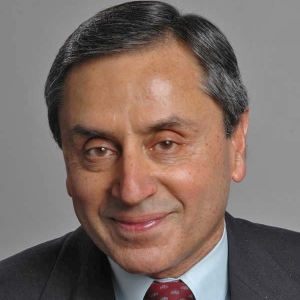Anil K. Chopra
782 Davis Hall

Anil K. Chopra received his Bachelor of Science degree in Civil Engineering from Banaras Hindu University, India, in 1960, the Master of Science degree from the University of California, Berkeley, in 1963, and the Doctor of Philosophy degree, also from Berkeley, in 1966.
He joined the faculty at the University of California, Berkeley, in 1969 where he has served as Vice Chair (1980–83) and Chair (1991–93, 1994–97) of the Structural Engineering, Mechanics and Materials program in the Department of Civil and Environmental Engineering. He has been responsible for the development and teaching of courses in structural engineering, structural dynamics, and earthquake engineering.
His research activities have included studies of structural dynamics, various problems in earthquake analysis and design of buildings, dynamic soil structure interaction, dynamic fluid structure interaction, and earthquake analysis and design of concrete dams. He has authored more than 380 published papers on this work, a monograph, Earthquake Dynamics of Structures, A Primer, 2005, and a textbook, Dynamics of Structures: Theory and Applications to Earthquake Engineering, 1995, 2001, 2007, 2012, and 2017. The S.I. edition of this book was published in 2015. The book has been translated into Japanese, Chinese, Korean, Greek, Turkish, Spanish, and Farsi.
He serves as a consultant on earthquake engineering problems to numerous governmental and private organizations in several countries. He has served several professional societies in various positions: Chairman (1986) of the Engineering Mechanics Division Executive Committee, and Chairman (1991) of the Structural Division Executive Committee, American Society of Civil Engineers; Board of Directors of the Earthquake Engineering Research Institute (1990–93), Structural Engineers Association of Northern California (1987–89), the Seismological Society of America (1982–83), and the Applied Technology Council (1972–74); and Chairman of the National Research Council Committee on Natural Disasters (1982–83). Currently, he serves as Executive Editor of Earthquake Engineering and Structural Dynamics, the journal of the International Association for Earthquake Engineering.
He has received the following honors: the University Gold Medal (1960) and the Distinguished Alumnus Award (1980) from Banaras Hindu University; the Ernest E. Howard Award (1998), the Nathan M. Newmark Medal (1993), the Norman Medal four times (2013, 2001, 1991, and 1979), the Raymond C. Reese Research Prize (1989), and the Walter L. Huber Research Prize (1975), all of the American Society of Civil Engineers; the Housner Medal (2002) from the Earthquake Engineering Research Institute; and the AT&T Foundation Award of the American Society for Engineering Education (1987). At the University of California at Berkeley he was appointed Miller Research Professor for the Fall Semester, 1990, and for the 2003‑2004 academic year, was named to the Horace, Dorothy, and Katherine Johnson Chair in Engineering in 1992, and received the Distinguished Teaching Award in 1999. He was elected to the National Academy of Engineering in 1984, as an Honorary Member of the International Association for Earthquake Engineering in 2004, Fellow of the Structural Engineers Association of California (2004), and an Honorary Member of the Structural Engineers Association Northern California (2010). He received the Doctor Honnoris Causa from the Technical University of Engineering, Bucharest, Romania in 2007, and the Honorary Professor title from Harbin Institute of Technology, China, in 2009. In 2009 the magazine International Water, Power & Dam Construction listed him among the “60 most influential people in the hydropower and dams industry” who “helped shape the course of the global hydro and dams business over the last 60 years.” In 2011 the same magazine listed him among “Influencing Engineering…the 20 people who have made the biggest difference in the dam engineering sector over the past ten years.” In 2012 he received the “National Award for Significant Contributions in Science and Technology,” from SENACYT: La Secretaria Nacional de Ciencia, Technologia & Innovacion, Panama. In 2013 he was honored by the American Society of Civil Engineers twice; he received the Norman Medal and was elected as a Fellow in the Engineering Mechanics Institute. In 2014, he was elected as an Honorary Fellow by the Indian Society for Earthquake Technology. He was awarded the Berkeley Citation, University of California, Berkeley, 2016, “for distinguished achievement and for notable service to the University.” In March 2017 he was elected as an Honorary Member of the Earthquake Engineering Research Institute in recognition of his sustained and outstanding contributions in the field of earthquake engineering. He presented the Newmark Distinguished Lecture for 2017 at the University of Illinois at Urbana-Champaign. In 2017 he was elected to the Academy of Civil and Environmental Engineering Distinguished Alumni, the University of California, Berkeley. Finally he received The Nigel Priestley Prize (formerly the Rose School Prize), 2018, Pavia, Italy, to honor individuals for creativity, innovation, research, and professional achievements and excellence in education in the field of earthquake engineering and engineering seismology.
Ph.D. - Civil Engineering, University of California at Berkeley, 1966
M.S. - Civil Engineering, University of California at Berkeley, 1963
B.Sc. - Civil Engineering, Banaras Hindu University, India, 1960
MODELING VISCOUS DAMPING IN NONLINEAR RESPONSE HISTORY ANALYSIS OF BUILDINGS
The Rayleigh damping model, which is pervasive in nonlinear response history analysis (RHA) of buildings, is shown to develop “spurious” damping forces and lead to inaccurate response results. We prove that a viscous damping matrix constructed by superposition of modal damping matrices—irrespective of the number of modes included or values assigned to modal damping ratios—completely eliminates the “spurious” damping forces. This is the damping model recommended for nonlinear RHA.
Replacing the stiffness proportional part of Rayleigh damping by the tangent stiffness matrix is shown to improve response results. However, this model is not recommended because it lacks a physical basis and has conceptual implications that are troubling: hysteresis in damping force—velocity relationship and negative damping at large displacements. Furthermore, the model conflicts with the constant-damping model that has been the basis for fundamental concepts and accumulated experience about the inelastic response of structures.
With a distributed plasticity model, the structural response is not sensitive to the damping model; even the Rayleigh damping model leads to acceptable results. This perspective on damping provides yet another reason to employ the superior distributed plasticity models in nonlinear RHA. OpenSees software has been extended to include a damping matrix defined as the superposition of modal damping matrices. Although this model leads to a full populated damping matrix, the additional computational demands are demonstrated to be minimal.
Collaborators:
- Dr. Frank McKenna, PEER
Publications:
- A. K. Chopra and F. McKenna, “Modeling Viscous Damping in Nonlinear Response History Analysis of Buildings,” Proceedings, 16th World Conference on Earthquake Engineering, Santiago, Chile, January 2017 .
- A. K. Chopra, and F. McKenna, “Author’s Reply to John Hall’s Discussion (EQE-16-0008) to Chopra and McKenna’s Paper, ‘Modeling Viscous Damping in Nonlinear Response History Analysis of Buildings for Earthquake Excitation,’” Earthquake Engineering and Structural Dynamics, Vol. 45, No. 13, pp. 2235–2238, October 2016 .
- A. K. Chopra, and F. McKenna, "Modeling Viscous Damping in Nonlinear Response History Analysis of Buildings for Earthquake Excitation," Earthquake Engineering and Structural Dynamics, Vol. 45, No. 2, pp. 193–211, February 2016.
SELECTION AND SCALING OF GROUND MOTIONS FOR NONLINEAR RESPONSE HISTORY ANALYSIS OF BUILDINGS
The earthquake engineering profession has been moving away from traditional code procedures to performance-based procedures for evaluating existing buildings and proposed designs of new buildings. Although nonlinear static (or pushover) analysis continues to be used for estimating seismic demands, nonlinear response history analysis (RHA) is now being increasingly employed. In the latter approach, engineering demand parameters (EDPs)—floor displacements, story drifts, member forces, member deformations, etc.—are determined by nonlinear RHA of a computer model of the building for an ensemble of multi-component ground motions. Fraught with several challenging issues, selection and scaling of ground motions necessary for nonlinear RHA remains a subject of much research in recent years.
Most existing procedures to modify or scale ground motion records fall into one of two categories: spectrum matching and amplitude scaling. Both classes of procedures—spectral matching and amplitude scaling—are essentially limited to one component of ground motion, whereas ground motion is three dimensional, and three components (two horizontal and one vertical) are required in dynamic analysis of complex structures.
In spectrum matching procedures, wavelets are added to recorded motion such that the response spectrum for the modified ground motion matches closely the target spectrum. Modifying the time variation of the recorded ground motion distorts these records, making them inconsistent relative to the physical characteristics of the earthquake source. Thus, this approach is fundamentally inconsistent relative to the science of seismology.
The objective of amplitude scaling procedures is to determine scale factors for a small number of records such that the scaled records provide an accurate estimate of the benchmark structural response. Amplitude scaling of ground motions, while retaining the time variation of records, is also problematic in a fundamental sense. It contradicts the recorded evidence that the characteristics of ground motions are strongly dependent on earthquake magnitude and distance, e.g., frequency characteristics, time variation, and duration of ground motions differ significantly between moderate and large earthquakes, and whether the motions are recorded close to or far from the earthquake source.
The objective of our research is to develop the concepts and methodologies for defining three components of ground motions that are consistent with the seismic hazard for the site, faithful to seismological science, conform to recorded ground motion data, and reflects the statistical variability intrinsic to ground motions.
Completed Ph.D. students:
- Neal Simon Kwong, 2015
Collaborators:
- Dr. Robin K. McGuire
- Professor Neal Simon Kwong
Publications:
- N. S. Kwong, and A. K. Chopra, “A Generalized Conditional Mean Spectrum and its Application for Intensity-Based Assessments of Seismic Demands,” Earthquake Spectra, Vol. 33, No. (1): pp. 123–143, February 2017 .
- N. Simon Kwong, and A. K. Chopra, “Evaluation of the Exact Conditional Spectrum and Generalized Conditional Intensity Measure Methods for Ground Motion Selection, Earthquake Engineering and Structural Dynamics, Vol. 45, No. 5, pp. 757–777, April 2016.
- N. Simon Kwong, A. K. Chopra, and R. K. McGuire, "A Ground Motion Selection Procedure for Enforcing Hazard Consistency and Estimating Seismic Demand Hazard Curves,;quot; Earthquake Engineering and Structural Dynamics, Vol. 44, No. 14, pp. 2467–2487, November 2015.
- N. Simon Kwong, A. K. Chopra, and R. K. McGuire, "Evaluation of Ground Motion Selection and Modification Procedures using Synthetic Ground Motions," Earthquake Engineering and Structural Dynamics, Vol. 44, No. 11, pp. 1841–1861, September 2015.
- N. Simon Kwong, A. K. Chopra, and R. K. McGuire, ;quot;Author’s Reply to the Discussion by Brendon A. Bradley of 'A Framework for the Evaluation of Ground Motion Selection and Modification Procedures'" Earthquake Engineering and Structural Dynamics, Vol. 44, No. 5, pp. 823–828, April 2015.
- N. Simon Kwong, A. K. Chopra, and R. K. McGuire, "A Framework for the Evaluation of Ground Motion Selection and Modification Procedures," Earthquake Engineering and Structural Dynamics, Vol. 44, No. 5, pp. 795–815, April 2015.
EARTHQUAKE ANALYSIS, DESIGN, AND SAFETY EVALUATION OF CONCRETE ARCH DAMS
Seismic safety evaluation of proposed or existing concrete dams requires analysis of a large three-dimensional finite element (FE) model of the dam including several factors: dam-water interaction, including water compressibility, reservoir bottom interaction, and the large extent of the reservoir in the upstream direction: dam-foundation interaction, including foundation inertial effects, material and radiation damping, and the semi-infinite extent of the foundation rock. Over the past three decades, research has conclusively demonstrated that these factors significantly influence the earthquake response of dams and must be rigorously treated.
Although dam-water-foundation interaction effects are rigorously treated in EAGD-84 and EACD-3D-96, these computer codes, resulting from our previous research, have several limitations: linear systems, homogeneous foundation rock, uniform canyon, and spatially-uniform ground motion, assumptions that are inappropriate for many practical situations. Thus these programs cannot consider concrete cracking, dam sliding, or other nonlinear effects such as: non-homogeneous foundations or irregular reservoir geometry, and spatial variations that invariably exist in ground motion around the canyon. All of these factors are often important in practical application.
Recently, the EACD computer program has been extended to include spatial variations in ground motion at the dam-rock interface. The excitation, defined as the free-field ground motion at the dam-foundation rock interface, is specified at every node on the interface. Even in the case of the most extensively instrumented dams, however, such ground motion data is recorded at few locations at most. Therefore, a procedure to interpolate (and extrapolate) the ground motions at all nodes along the interface is presented.
By comparing computed structural responses to the earthquake motions recorded at two arch dams—Mauvoisin Dam, Switzerland, and Pacoima Dam, California—it is demonstrated that damping values assigned to the dam alone and the foundation rock separately must be consistent with damping “measured” from forced vibration tests or system identification methods applied to recorded motions during small earthquakes; the measured damping reflects the total energy dissipation in the overall dam-water-foundation rock system due to several mechanisms. The most important implication is that the current practice of specifying a viscous damping ratio of 5% for the concrete dam alone and a similar value for the foundation rock separately should be abandoned because it is likely to lead to excessive damping in the overall dam-water-foundation rock system, unless the foundation-rock is much softer than concrete.
Spatial variations in ground motion, typically ignored in dam engineering practice, can have profound influence on the earthquake-induced stresses in the dam. This influence obviously depends on the degree to which ground motion varies spatially along the dam-rock interface. Thus, for the same dam, this influence could differ from one earthquake to the next, depending on the epicenter, location, and focal depth of the earthquake relative to the dam site. We are currently working on developing a direct finite element method for nonlinear response analysis of concrete dams interacting with semi-unbounded fluid and foundation work domains, subjected to earthquake excitation defined at a control point. This has been implemented for 2D analysis of gravity dams and validated against the substructure method (EAGD-1984). Implementation of the method for 3D systems is in progress.
Current Graduate Student:
- Arnkjell Lokke
Completed Ph.D. student:
- Ushnish Basu, 2004
Collaborators:
- Dr. Ushnish Basu, LSTC, Inc.
- Larry Nuss, Bureau of Reclamation
- Jinting Wang, Tsinghua University, China
Publications:
- A. Lökke and A. K. Chopra, “Direct Finite Element Method for Nonlinear Analysis of Semi-Unbounded Dam–Water-Foundation Rock System,” Earthquake Engineering and Structural Dynamics, Vol. 46, No. (8): pp. 1267–1285, July 2017.
- A. Lökke and A. K. Chopra, “A Finite Element Analysis Procedure for Earthquake Analysis of Dam-Water–Foundation Rock Systems: Validation of Method for 2D Problems,” Proceedings, 16th World Conference on Earthquake Engineering, Paper No. 1099, Santiago, Chile, January 2017.
- A. Lokke and A. K. Chopra, "Response Spectrum Analysis of Concrete Gravity Dams Including Dam–Water–Foundation Interaction," ASCE, Journal of Structural Engineering, Vol. 141, No. 8, pp. 4014202-1–04014202-9.
- A. K. Chopra, "Comparison of Recorded and Computed Responses of Arch Dams," Proceedings, International Symposium on Dams, Kyoto, Japan, June 2012.
- A. K. Chopra, "Earthquake Response Analysis Procedures for Evaluating and Upgrading Existing Arch Dams for Seismic Safety," CD-ROM Proceedings, ICOLD 12, Kyoto, Japan, June 2012.
- F. Lopez and A. K. Chopra, "Response-History Analysis of the Moondarra Intake Tower: A Novel Approach Based on New Methodologies for Performance Requirements," CD-ROM Proceedings, ICOLD 12, Kyoto, Japan, June 2012.
- A. K. Chopra, "Earthquake Analysis of Arch Dams: Factors To Be Considered," ASCE, Journal of Structural Engineering, Vol. 138, No. 2, pp. 205–214, February 2012.
- A. K. Chopra and J.-T. Wang, "Earthquake Response of Arch Dams to Spatially Varying Ground Motions," Earthquake Engineering and Structural Dynamics, Vol. 39, No. 8, pp. 887–906, July 2010.
- J.-T. Wang and A. K. Chopra, "Linear Analysis of Concrete Arch Dams including Dam-Water-Foundation Rock Interaction considering Spatially Varying Ground Motions," Earthquake Engineering and Structural Dynamics, Vol. 39, No. 7, pp. 731–750, June 2010.
- A. K. Chopra and L. Nuss, "Seismic Safety Evaluation and Upgrading of Arch Dams," Proceedings, ICOLD 09, Brasilia, Brazil, May 21–24, 2009.
- J.-T. Wang and A. K. Chopra, "EACD-3D-2008: A Computer Program for Three Dimensional Earthquake Analysis of Concrete Dams Considering Spatial-Varying Ground Motion," UCB/EERC-2008-04, Earthquake Engineering Research Center, University of California, Berkeley, December 2008, 150 pgs.
- A. K. Chopra and J.-T. Wang, "Analysis and Response of Concrete Arch Dams Including Dam-Water-Foundation Rock Interaction to Spatially-Varying Ground Motions," UCB/EERC–2008–03, Earthquake Engineering Research Center, University of California, Berkeley, December 2008, 127 pgs.
- A. K. Chopra, "Earthquake Analysis of Arch Dams: Factors To Be Considered," Proceedings, CD-ROM, Paper No. S. 039, 14th World Conference on Earthquake Engineering, Beijing, China, October 12–17, 2008.
- U. Basu and A. K. Chopra, "Perfectly Matched Layers for Transient Elastodynamics of Unbounded Domains," International Journal for Numerical Methods in Engineering, Vol. 59, pp. 1039–1074, March 2004.
- U. Basu and A. K. Chopra, "Perfectly Matched Layers for Time-Harmonic Elastodynamics of Unbounded Domains: Theory and Finite-Element Implementation," Computational Methods in Applied Mechanics and Engineering, Elsevier, Vol. 192, pp. 1337–1375, March 2003.
News
No mentions in News
Spotlights
No mentions in Spotlights
Student Updates
No mentions in Student Updates


